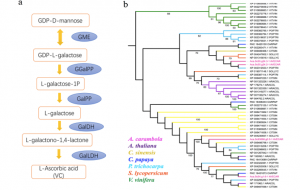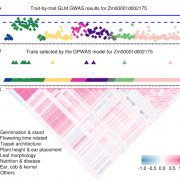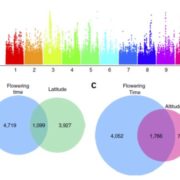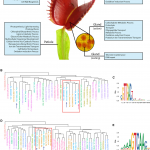Dissecting the genome of star fruit (Averrhoa carambola L.) (Hort. Res.)
 Starfruit is a sweet and sour fruit that has a shape of a five-point star. It belongs to the Oxalidaceae family and is a fruit of Averrhoa carambola, a species of tree native to tropical Southeast Asia. The fruit is consumed in many parts of the world and is known for its many economic, medicinal and nutritional benefits. Despite their popularity in a number of dishes, starfruit have not been well studied at the genetic level due to the lack of genome information. In this study, Fan et al. report the first draft of the genome information of the Oxalidaceae family. They assembled a total genome size of 470.51Mb and obtained 24,726 protein-coding genes including some nucleotide-binding site (NBS) genes that are important for disease resistance. Furthermore, the authors analyzed the evolutionary history of the fruit alongside 10 other species and found that A. carambola seperated from Populus trichocarpa (black cottonwood) approximately 94.5 million years ago. Finally, they identified some enzymes involved in the synthesis of nutritional metabolites including the vitamin C, vitamin B2, oxalate, and flavonoid metabolic pathways. This research provides an important resource for further studies on the nutritional, medicinal and economic importance of starfruit. (Summary by Modesta Abugu, @modestannedi) Hort. Res. 10.1038/s41438-020-0306-4
Starfruit is a sweet and sour fruit that has a shape of a five-point star. It belongs to the Oxalidaceae family and is a fruit of Averrhoa carambola, a species of tree native to tropical Southeast Asia. The fruit is consumed in many parts of the world and is known for its many economic, medicinal and nutritional benefits. Despite their popularity in a number of dishes, starfruit have not been well studied at the genetic level due to the lack of genome information. In this study, Fan et al. report the first draft of the genome information of the Oxalidaceae family. They assembled a total genome size of 470.51Mb and obtained 24,726 protein-coding genes including some nucleotide-binding site (NBS) genes that are important for disease resistance. Furthermore, the authors analyzed the evolutionary history of the fruit alongside 10 other species and found that A. carambola seperated from Populus trichocarpa (black cottonwood) approximately 94.5 million years ago. Finally, they identified some enzymes involved in the synthesis of nutritional metabolites including the vitamin C, vitamin B2, oxalate, and flavonoid metabolic pathways. This research provides an important resource for further studies on the nutritional, medicinal and economic importance of starfruit. (Summary by Modesta Abugu, @modestannedi) Hort. Res. 10.1038/s41438-020-0306-4









